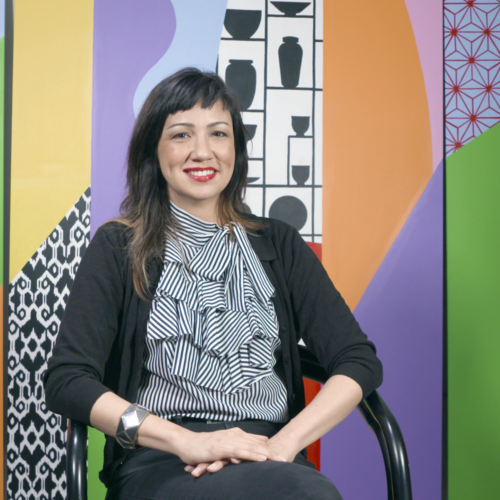

Scroll down to find packets with artist biographies, interdisciplinary lesson plans, and hands-on art activities that celebrate Asian American Pacific Islander Heritage.

Known for his screen printing and abstract expressionist paintings, Arthur Okamura (1932–2009) was a Japanese American artist who rose to prominence in the 1960s as a book illustrator and member of an artist community based in Bolinas, California. After being incarcerated at the Granada War Relocation Center in Colorado during World War II, Okamura and his family moved to Chicago. He attended the Art Institute of Chicago, Yale School of Art, and University of Chicago before returning to California in 1956, where he taught for 31 years at Oakland’s California College of the Arts. His work can be found in the collections of multiple major art museums and at the New School at Commonweal in Bolinas, California, where he served on the board of directors.
Image credit: Arthur Okamura (February 24, 1932 – July 10, 2009). Photograph by Ron Garrigues, 2006.
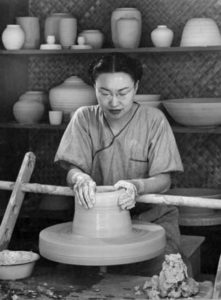
Jade Snow Wong (1922–2006) was a celebrated ceramics and enamels artist and one of the first writers on the 20th-century Chinese American experience. The theme of “working with your hands” resonated throughout her life: she saw her immigrant parents laboring with their hands in their garment factory; she cooked and cleaned as a maid to pay for her college education; she wrote her best-selling memoirs by hand and on the typewriter; she personally handled matters (objects and tours) in her import/export and travel businesses; and, of course, she worked with her hands as an artist. The acclaim she received for her art and writing led the U.S. State Department to ask her to serve as a cultural ambassador speaking to audiences throughout Asia.
Image courtesy of artist’s family
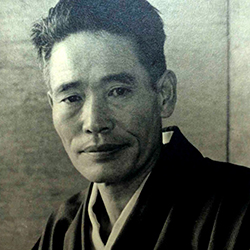
Chiura Obata (1885–1975) was a renowned landscape artist, professor, and devoted environmentalist. Born in 1885 in Japan, Obata studied ink painting before immigrating to California in 1903, settling in San Francisco’s Japantown. After an influential trip to Yosemite, Obata began devoting his art to portraying the beauty of nature. Throughout the next decade, he continued to earn recognition, but like many Japanese Americans during WWII, his life was violently uprooted as his family was interned. During his imprisonment, Obata was able to start art schools at two internment camps, teaching hundreds of students. After the end of the war, Obata lectured at UC Berkeley, joined the Sierra Club’s environmentalist efforts, and consistently celebrated Japanese aesthetics until his death in 1975. Over the course of a seven-decade career, Obata became a prominent educator at UC Berkeley and a central leader in the California Art scene.
Image courtesy of Brainpickings
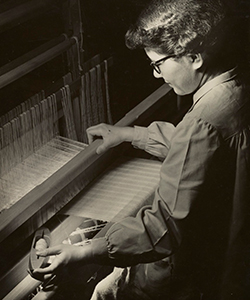
Kay Sekimachi (b. 1926) was born and raised in San Francisco. Her interest in art began when she learned how to fold origami figures, as well as paint and draw, while in an incarceration camp for Japanese Americans during World War II. In 1946, Sekimachi enrolled at the California College of the Arts in Oakland, California, where she studied weaving on the loom. She became so adept at that labor-intensive process that she is often referred to as a “weaver’s weaver” and is recognized as a pioneer in resurrecting fiber as a medium of artistic expression. Today, Sekimachi is best known for three-dimensional sculptural forms that take inspiration from the ancient cultures of her ancestral homeland of Japan. She is still weaving today in her workshop in Berkeley, California.
Image credit: Kay Sekimachi, 1950. Photographic Print. Bob Stocksdale and Kay Sekimachi papers, ca. 1900–2015. Archives of American Art, Smithsonian Institution, 6244.
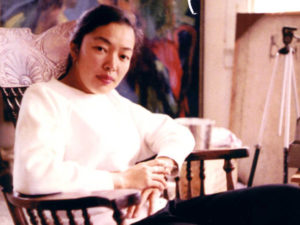
Bernice Bing (1936–1998), or “Bingo,” was a queer Chinese American Abstract Expressionist artist. Born in San Francisco’s Chinatown, Bing’s early life was marked by adversity: orphaned at the age of six, she lived in a variety of homes during her childhood. In 1958, Bing began attending California College of Arts and Crafts in Oakland, California. Here, under the influence of her professors, she began exploring what it meant to be an American-born, queer, ethnically Chinese artist. Her fascination with East Asian philosophy, especially Zen Buddhism, can be seen throughout her work. In 1961, Bing graduated with an M.F.A. from the San Francisco Art Institute. A devoted artist and activist, she supported many arts organizations throughout the Bay Area. Bing’s contributions to the New York–centric, male-dominated field of Abstract Expressionism were overlooked during her lifetime, but her work of exploring identity and supporting the arts are contributions that will inspire generations to come.
Image courtesy of Collection of Bernice Bing Estate
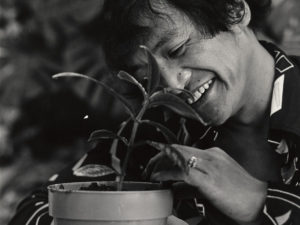
Carlos Villa (1936-2013) is best known for his teaching, activism, and dynamic work. He grew up in San Francisco’s Tenderloin neighborhood, attended the San Francisco Art Institute, where he later became a professor, and earned an M.F.A. from Mills College in Oakland, California. While he began as a Minimalist artist, Villa was committed to exploring of his own Filipino American background and spotlighting forgotten or neglected art and artists of the post–World War II era. He wanted to rebalance the period canon by reviving artistic cultures that had been disrupted by colonization and war. Through teaching and curating — he organized several important exhibitions and produced multimedia projects and performances — Villa influenced many young artists. Today, he is remembered for his activism as well as his contributions to Filipino American art.
Image credit: Carlos Villa, 1980, by Mimi Jacobs (American, 1911–1999). Photographic print. Archives of American Art, Smithsonian Institution, 5034.

Born in San Francisco, Leo Valledor (1936–1989) was a Filipino American artist known for his shaped canvases, in which he experimented with the spatial aspects of color. Losing both of his parents by the time he was 12, Valledor grew up in the Fillmore District and saw jazz and Beat poetry as powerful influences. In 1955, when he was only 19, he held his first solo show at the legendary Six Gallery. Valledor spent the 1960s in New York, where he co-founded the Park Place Gallery Group. In geometric paintings that furthered the hard-edge movement, Valledor used the shaped canvas to manipulate what the viewer saw. Valledor returned to San Francisco in 1968, where he maintained a relatively low profile as an artist and teacher until his death in 1989. His contribution to the arts has only recently been fully appreciated; he is now recognized as a maverick of Minimalism.
Image courtesy of Mimi Jacobs, Wikiart, http://en.wikipedia.org/wiki/Leo_Valledor
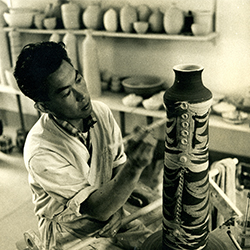
Born in Manteca, California, Ernie Kim (1918–1997) originally attended Los Angeles City College to become a dentist. However, when the United States entered World War II, he left his studies to serve as an Army parachute lieutenant. As part of his occupational therapy after the war, Kim took ceramics classes through the Veterans Administration and found a new path. Kim became a ceramics teacher, teaching in the Palo Alto Unified School District in 1952, serving as the head of the ceramics department at the San Francisco Art Institute in 1956, and then directing the Richmond Art Center from 1970 to 1980. As an artist, Kim was praised for creating “quietly beautiful” vessels featuring “subtle manipulation of surfaces.” Having endured extreme isolation during his incarceration as a prisoner of war, Kim immersed himself in community throughout his teaching career. After his death, the Richmond Art Center created the annual Ernie Kim Award in his honor.
Image credit: Ernie Kim, approx. 1950s. Courtesy of Asian American Art Project, Stanford University. From Chang, Gordon H., Mark Johnson, and Paul Karlstrom, eds. “Asian American Art: A History, 1850–1970.” Stanford, CA: Stanford University Press, 2008: 351–352.

Ruth Aiko Asawa Lanier (1926–2013) was a prominent sculptor, public artist, and tireless arts education advocate. Born in California to Japanese parents, Asawa’s early life was spent with her large family in rural Southern California. In 1942, with the signing of Executive Order 9066, the Asawas were forced to leave their family farm. While incarcerated at the Rohwer Relocation Center in Arkansas, Asawa graduated high school. After being allowed to leave the camps, Asawa transferred to Black Mountain College in North Carolina, where she met her future husband, architect Albert Lanier. In the 1950s, the couple moved to San Francisco and started a family. As their family expanded to include six children, Asawa worked in a home studio, slowly gaining recognition as an artist. Asawa was also a committed arts advocate and was a driving force behind the creation of the San Francisco School of the Arts, now named in her honor. A true artistic pioneer, Asawa challenged conceptions of what it meant to be an Asian American, a mother, a fine artist, and a public arts advocate.
Image credit: Untitled (Ruth Asawa holding a looped wire sculpture), 1952, by Imogen Cunningham (American, 1883–1976). Sepia toned gelatin silver print. FAMSF, Gift of Ruth Asawa and Albert Lanier, 2006.114.1.

Learn about the impact of Asian American women artists from the Bay Area, past and present, in this virtual workshop featuring guest artist Jenifer K Wofford. Wofford, a Filipina American artist and educator based in San Francisco, discusses her mural Pattern Recognition, the first commission for the museum’s new Lawrence and Gorretti Lui Hyde Street Art Wall.